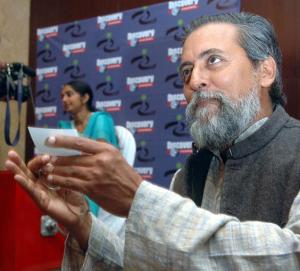
A farmer is comparable to a one man University.
“A single person combines in himself the work of a weatherman, an engineer, a marketing executive, a veterinarian, and above all a statesman endowed with the responsibility of feeding his people, says Mr G. R. Sakthivel an enterprising and innovative farmer from Sathyamangalam, Erode, Tamil Nadu.
A member of the scientific advisory committee of MYRADA-KVK and Erode district organic farmers’ federation, Mr. Sakthivel developed a simple yet effective mechanism to filter cattle waste and use the same in sugarcane cultivation.
Four compartments
The four compartment system includes the filtration technique, ensuring that an enriched solution gets collected at the end, mixed with water, and sent by drip irrigation system to the field.
The first section is meant for collection of cow dung and urine mixing. After thorough mixing, the solution is sent to the second compartment for first filtration.
The solid matter is used for biogas production and the upper part of the solution is then allowed to flow into a third compartment where jaggery is added for fermentation. The clear enriched filtrated medium is collected and used for irrigation.
By adopting this technology the farmer can save Rs.27,000 per acre as it reduces labour and fertilizer cost, according to Mr. Sakthivel. This technology aids water holding capacity in the soil and presence of earth worms is considerably increased in the fields.
A believer in organic cultivation, Mr. Sakthivel says that “one of the main reasons that encouraged me to develop this technique was the decreasing quality of soil due to the continuous usage of chemicals for growing crops.”
Cattle resources
“Fertilizers not only affect one’s health considerably, but also decrease the quantity of yield. I worked on this innovation to do away with the use of fertilizers, and use available cattle resources for the purpose of soil nourishment.” he says.
Decreased availability of labour also acted as a catalyst in the process of innovation for this farmer.
“The increase in sugarcane yield in the farmers fields are a standing proof for the success of this innovation. From 60 tonnes in the first harvest, the yield increased to 63 tonnes in the second harvest. The crop, now in its third harvest, is expected to yield higher,” says agricultural expert Mr Saravana Kumar. Priced at Rs.20,000 the filtering system can be used for other crops as well.
Successful model
Bannariamman sugar factory at Sathyamangalam area identified this technology as an alternative suitable farming practice and the Sugarcane breeding institute, Coimbatore identified this as a successful model for addressing labour and fertilizer reduction in sugarcane cultivation.
“So far we have not received any complaints about the filtration use but in some places blockages in the drip irrigating tubes have been noticed. But we rectified it by using EM (Effective Microorganism) solution once in three months. The EM solution is also mixed with the end solution to flow in the drip tubes to prevent blockage,” says Dr. K. Alagesan, Program Co-ordinator, Myrada Krishi Vigyan Kendra,
Lot of queries
Till date about 10 farmers in the region and a few from Tirunelveli district are trying this technique in their fields.
“Farmers from Dharmapuri, Madurai and Dindigul are now approaching me to learn the technique. I did not innovate for an award. My greatest achievement would be to inspire as many farmers as I can, to take to organic farming methods. Organic farming is the only way to increase declining yields today,” says the farmer.
This, according to him is the real award. Mr. Sakthivel presented this technology at the 6th National level KVK conference at Jabalpur where nearly 1,000 delegates participated. Contact Mr. G.R.Sakthivel at No. 149, Ganeshapuram, Gettavadi(P.o), Talavadi (Via), Sathyamangalam(T.K), Erode District-638461, Mobile: 94863 16041.


